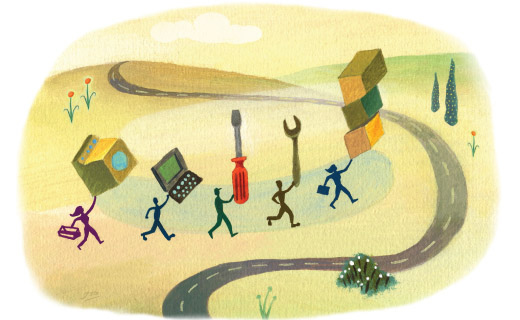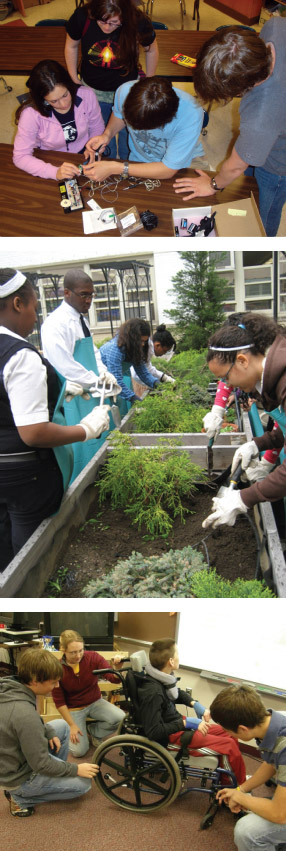A Winning Combination
+ BY THOMAS K. GROSE
+ ILLUSTRATION BY JOHN S. DYKES
EPICS draws high school students to engineering through community service.
Jessica Roggenbuck is midway through freshman year at the University of Toledo. If you had told her two years ago that she would be studying chemical engineering, however, you might have gotten a puzzled response. “Engineers? I thought they were train drivers,” she admits, with a laugh. But during her junior and senior years at Harbor Beach High School in Michigan, Roggenbuck developed a new appreciation for engineering when leading an after-school project to help charity food pantries track their inventories using a computer program she and other students had designed. “It helped me understand what an engineer does,” says Roggenbuck. It also influenced her decision to pursue an engineering degree.
The project Roggenbuck joined operates under the auspices of EPICS High, a national initiative based at Purdue University’s college of engineering. For the past four years, it has gained momentum from the push to get more American students interested in engineering – especially young women, minorities, and students from low-income families, all of whom remain woefully underrepresented in the field. The genius of EPICS – Engineering Projects in Community Service – is that it tackles this goal by engaging students in service learning.
Across the nation, service learning is taking off. Thirty-five states now have laws that either require schools to have service-learning policies or allow individual districts to enact their own. And more than 24 percent of U.S. elementary and secondary schools have adopted these programs. Studies have shown that students who do community service improve their academic performance. “So, we thought, ‘We’ve got this wave [in service learning]. Let’s see if we can ride it,’” says William C. Oakes, director of the EPICS program and an associate professor of engineering education at Purdue.
Engineers often try to interest K-12 students in the discipline by describing the current whiz-bang, cool technologies. Trouble is, Oakes says, that kind of pitch wins over only those already inclined to tech pursuits. Others remain unimpressed and disengaged. Yet many teens care about their communities and want to find ways to give back. EPICS High offers a pathway into the field by blending early engineering educational concepts into a school’s existing service-learning curriculum and focusing on projects that serve the community.
At the college level, EPICS has been around for some time, providing undergraduate engineering students the opportunity to tackle real-world projects by partnering with nonprofit organizations – often for academic credit. Created at Purdue in 1995, EPICS has grown to include 19 other universities, including Wisconsin, Penn State, and Princeton. Last year, 2,504 students nationally were involved in EPICS projects, learning along the way how to work on multidisciplinary teams and about the value of ethics and customer relations in engineering. Overseas, the University of Puerto Rico, Mayaguez and New Zealand’s University of Auckland have also signed on. EPICS was a sponsor of ASEE’s 2010 K-12 workshop.
Oakes was uncertain initially that EPICS could succeed at a pre-college level. Not many schools have qualified engineering teachers, and community-service programs are often coordinated by educators with no background in math or science. Undeterred, two Purdue EPICS alums, Sarah Nation and Jill Heinzen, pressed ahead with a test project at Indiana’s Bedford North Lawrence High School, near NSA Crane, the U.S. Navy base where they work. Together with some of their Crane engineering colleagues, the pair filled gaps in the teachers’ technical training. The Bedford students successfully designed a necklace monitor to help one of their classmates, who suffers from an underdeveloped swallowing reflex. The students have since applied for a patent for the monitor.
Persuaded that the EPICS concept could be tweaked for high schools, Oakes tapped into the country’s robust service-learning infrastructure to locate schools that would be a good fit. With a $1.5 million Learn and Serve America Grant from the Corporation for National Community Service, EPICS High pilot programs were begun at 33 schools in a mix of urban, suburban, and rural environs in six states. A three-year, $300,000 grant from the Martinson Foundation was used for teacher training.
Bring in the Experts
Schools that join EPICS High partner with local nonprofit organizations and seek out projects with a strong design element that fall into four broad categories: education, environment, access and abilities, and human services. The schools must also find engineers willing to provide expertise for a project. Some might draw faculty members or engineering students from a nearby college. Others reach out to engineers at local companies. That’s what ninth graders at the Pacific Ridge School in Carlsbad, Calif., did when they needed advice on converting a golf cart to solar power for their school’s maintenance staff. Ultimately, the golf-cart project was jettisoned, and the students turned to designing and building a briefcase-size, solar-powered charging station to provide power in communities lacking electricity. It has since been tested successfully for use in rural villages in Ecuador.
EPICS High emphasizes the importance of multidisciplinary teamwork. During Purdue’s initial summer teacher-training course, a team from McCutcheon High School included instructors of English, science, and special education, along with an education technology specialist. Their first in-school project had students designing and building three large toy trucks for a charity that provides free Christmas toys to low-income families. Lead teacher Cheryl McLean says of the trucks, “They had no bells or whistles; they were just old-fashioned trucks – but the students really did a quality job.” Not unexpectedly, when displayed among the other offerings for parents seeking toys, they were snatched up within 20 minutes. Senior Monica Del Real, 18, began another McCutcheon project last year, creating interactive PowerPoint lessons to teach phonics to early readers. It will eventually be made available to urban schools across the country via Say Yes America. The ongoing project, says Del Real, “makes things more real” than regular classes. “Just the idea that people are actually going to use it is exciting.”
Participating schools have strong praise for the program. California’s Pacific Ridge School places service learning at the core of its curriculum. So, “it made perfect sense for us to partner with Purdue,” says Todd Burckin, the lead EPICS teacher. The grant money for the projects and teacher training is also a welcome boost, says Scott Whipple, a science/technology outreach teacher in Michigan’s Huron Intermediate School District. “Our schools are really struggling right now, so a program like this is pretty exciting,” says Whipple. “It has something for everyone: students, teachers, the community.”
Oakes now hopes to expand EPICS High far beyond 33 schools, and to form more partnerships with businesses and nonprofits. “EPICS High is a huge lever that we can pull that can have a dramatic effect on a national level,” he says. The outlook appears promising: Companies such as Motorola, State Farm, and aerospace giant Rolls-Royce have committed funds for a variety of the program’s needs, including teacher training. But even as the program grows, Oakes is working to retain oversight and ensure that projects fall within its parameters. As a research-driven program, EPICS High needs to continue collecting data, he says. “We need to know what works and what doesn’t work in early engineering education.”
“This is what I love.”
So far, the data seem to suggest that EPICS High is achieving its goal of attracting more nontech-oriented students to engineering. Oakes has some early but “very encouraging” data from the most recent cohort of EPICS students. Twenty-seven percent began the program with no interest in engineering. But of that “no interest” group, 47 percent began expressing an interest in an engineering career after just one semester, and among the female students, 53 percent changed from no interest to interested.
EPICS High may also be making an impact demographically. Of the 1,875 students involved thus far with EPICS High, 42 percent are female and 37 percent are from underrepresented minorities or low-income families. At the Frederick Douglass Academy in Harlem in New York City, Jah Vin Vaughn, 18, worked on two environmental projects. One measured air quality in the school’s classrooms, hallways, and stairwells. The other was a solar-powered station that monitored water quality in the Harlem River, collecting physical and chemical data every 15 minutes. Learning by doing helped him appreciate that math errors can have repercussions, says Vaughn: “In regular math classes, if you make a mistake, there are no severe consequences.” The experience helped persuade him to pursue environmental engineering at City College of New York, where the computer skills he acquired through EPICS have given him an edge over other students.
Indiana’s McLean has started to witness similar enthusiasm: “More of our students now see [engineering] as a prospect,” she says. Of course, it has already had a salutary effect on Jessica Roggenbuck, who couldn’t be more resolute about chemical engineering. Says Roggenbuck: “This is what I love.”
Thomas K. Grose is Prism’s chief correspondent, based in the United Kingdom.
Category: Features

